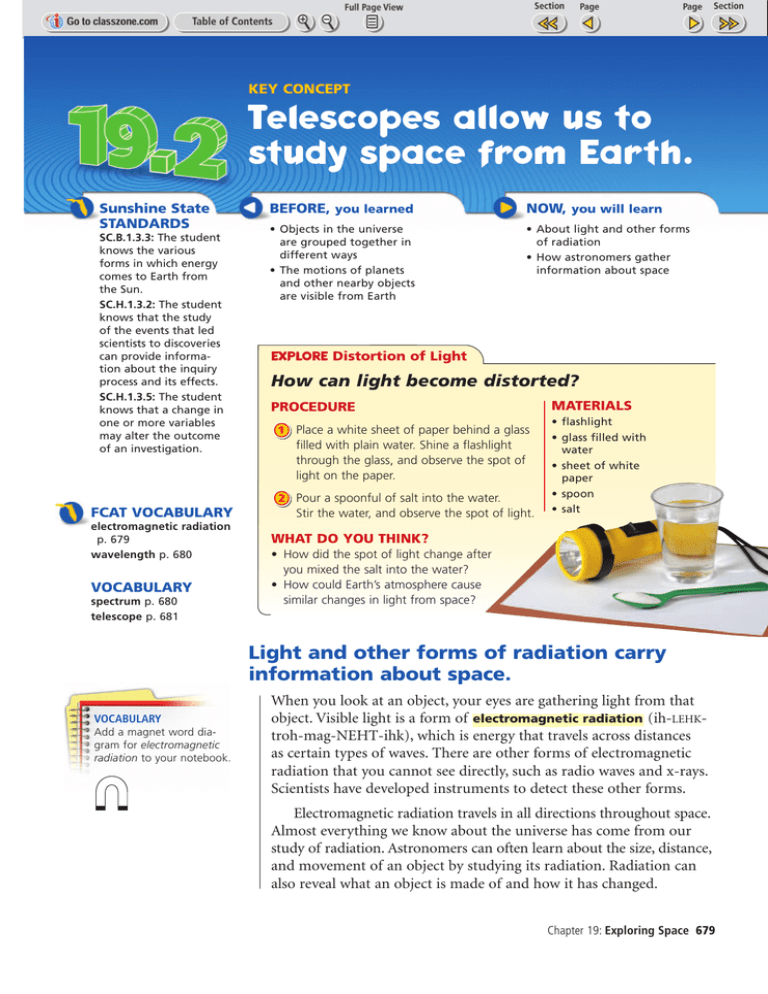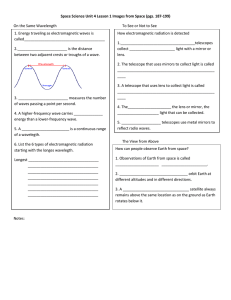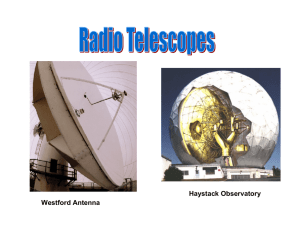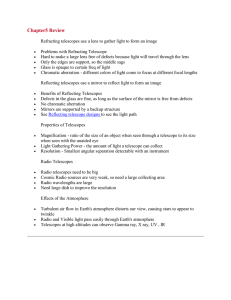Telescopes allow us to study space from Earth.
advertisement

KEY CONCEPT Telescopes allow us to study space from Earth. Sunshine State STANDARDS SC.B.1.3.3: The student knows the various forms in which energy comes to Earth from the Sun. SC.H.1.3.2: The student knows that the study of the events that led scientists to discoveries can provide information about the inquiry process and its effects. SC.H.1.3.5: The student knows that a change in one or more variables may alter the outcome of an investigation. BEFORE, you learned NOW, you will learn • Objects in the universe are grouped together in different ways • The motions of planets and other nearby objects are visible from Earth • About light and other forms of radiation • How astronomers gather information about space EXPLORE Distortion of Light How can light become distorted? PROCEDURE 1 Place a white sheet of paper behind a glass filled with plain water. Shine a flashlight through the glass, and observe the spot of light on the paper. 2 Pour a spoonful of salt into the water. FCAT VOCABULARY electromagnetic radiation p. 679 wavelength p. 680 VOCABULARY spectrum p. 680 telescope p. 681 Stir the water, and observe the spot of light. MATERIALS • flashlight • glass filled with water • sheet of white paper • spoon • salt WHAT DO YOU THINK? • How did the spot of light change after you mixed the salt into the water? • How could Earth’s atmosphere cause similar changes in light from space? Light and other forms of radiation carry information about space. VOCABULARY Add a magnet word diagram for electromagnetic radiation to your notebook. When you look at an object, your eyes are gathering light from that object. Visible light is a form of electromagnetic radiation (ih-LEHKtroh-mag-NEHT-ihk), which is energy that travels across distances as certain types of waves. There are other forms of electromagnetic radiation that you cannot see directly, such as radio waves and x-rays. Scientists have developed instruments to detect these other forms. Electromagnetic radiation travels in all directions throughout space. Almost everything we know about the universe has come from our study of radiation. Astronomers can often learn about the size, distance, and movement of an object by studying its radiation. Radiation can also reveal what an object is made of and how it has changed. Chapter 19: Exploring Space 679 The Electromagnetic Spectrum The different forms of electromagnetic radiation vary in their wavelengths. visible light wavelength radio waves microwaves infrared ultraviolet x-rays gamma rays Radio Waves Visible Light X-Rays This image of a galaxy shows where radio waves are emitted. Visible light is the only form of radiation our eyes can detect. This image shows where the same galaxy emits x-rays. reading tip A prism is a transparent object that is used to separate the wavelengths of light. If you shine a flashlight through a prism, the beam of white light will separate into a range of colors called a spectrum (SPEHK-truhm). The colors that make up visible light are red, orange, yellow, green, blue, indigo, and violet. These are the colors in a rainbow, which appears when light spreads out as it passes through raindrops. In a spectrum, the colors of visible light appear in the order of their wavelengths. Wavelength is the distance between one wave peak and the next wave peak. Red light has the longest wavelength. Violet light has the shortest. FLORIDA Content Preview reminder Electromagnetic waves are different from mechanical waves like ocean waves, but both carry energy. You will learn more about waves in grade 8. 680 Unit 6: Space Science As you can see in the illustration above, visible light is just a tiny part of a larger spectrum called the electromagnetic spectrum. The electromagnetic spectrum includes all the forms of electromagnetic radiation. Notice that the wavelength of infrared radiation is longer than the wavelength of visible light but not as long as the wavelength of microwaves or radio waves. The wavelength of ultraviolet radiation is shorter than the wavelength of visible light but not as short as the wavelength of x-rays or gamma rays. Check Your Reading How is visible light different from other forms of electromagnetic radiation? Astronomers use telescopes to collect information about space. A telescope is a device that gathers electromagnetic radiation. If you have ever looked through a telescope, it was probably one that gathers visible light. Such telescopes provide images that are much clearer than what is seen with the naked eye. Images from other types of telescopes show radiation that your eyes cannot detect. Each form of radiation provides different information about objects in space. Astronomers usually record images from telescopes electronically, which allows them to use computers to analyze images. Different colors or shades in an image reveal patterns of radiation. For example, in the right-hand image on page 680, the colors yellow and red indicate where the galaxy is emitting large amounts of x-rays. Most types of telescopes gather radiation with a glass lens or a reflecting surface, such as a mirror. Larger lenses and reflecting surfaces produce brighter and more detailed images. You can magnify an image from a telescope to any size. However, enlarging an image will not bring out any more details of an object. If the image is fuzzy at a small size, it will remain fuzzy no matter how much it is enlarged. Visible-Light, Infrared, and Ultraviolet Telescopes There are two types of visible-light telescopes: reflecting telescopes and refracting telescopes. Reflecting telescopes can also be built to gather infrared or ultraviolet radiation. This type of telescope has a curved mirror that gathers light. The image comes into focus in front of the mirror. Many reflecting telescopes have a second mirror that reflects the image to recording equipment or to a lens called an eyepiece. • Reflecting Telescope • Refracting Telescope This type of telescope has an objective lens, or curved piece of glass, at one end of a long tube. The lens gathers light and focuses it to form an image near the other end of the tube. An eyepiece magnifies this image. Reflecting Telescope Refracting Telescope eyepiece objective lens main mirror eyepiece secondary mirror Chapter 19: Exploring Space 681 Radio Telescope Most powerful visible-light telescopes are built on mountaintops in rural areas. Rural areas offer a much better view of the night sky than cities do, because the many electric lights in cities make dim space objects hard to see. By locating telescopes on mountaintops, astronomers reduce problems caused by Earth’s atmosphere. The atmosphere interferes with light coming in from space. In fact, movements of the air are what make stars appear to twinkle. At high altitudes there is less air above the ground to interfere with light. Radio Telescopes Radio telescopes show where radio waves are being emitted by objects in space. A radio telescope has a curved metal surface, called a dish, that gathers radio waves and focuses them onto an antenna. The dish works in the same way as the main mirror of a reflecting telescope. Some radio telescopes have dishes made of metal mesh rather than solid metal. Because radio waves are so long, a single radio telescope must be very large to produce useful images. To improve the quality of images, astronomers often aim a group of radio telescopes at the same object. Signals from the telescopes are combined and then converted into an image. Groups of radio telescopes, like the Very Large Array in New Mexico, can show more detail than even the largest single dish. Signals from these radio telescopes in New Mexico can be combined to produce clearer images. Unlike visible-light telescopes, radio telescopes are not affected by clouds or bad weather. They even work well in daylight. In addition, radio telescopes can be located at low altitudes because most radio waves pass freely through Earth’s atmosphere. check your reading RESOURCE CENTER CLASSZONE.COM Find out more about telescopes. 682 Unit 6: Space Science What is the function of the dish in a radio telescope? Telescopes in Space Many exciting images have come from the Hubble Space Telescope and other telescopes in space. The Hubble telescope is a reflecting telescope. It was placed in orbit around Earth in 1990. Astronomers operate it from the ground, although astronauts have visited it to make repairs and improvements. The telescope sends images and measurements back to Earth electronically. The Hubble Space Telescope produced this image of a part of a galaxy where new stars are appearing. Because the Hubble telescope is located in space, Earth’s atmosphere does not interfere with light from objects the telescope is aimed at. This lack of interference allows it to obtain clearer images than ground-based telescopes with much larger mirrors. In addition to collecting visible light, the Hubble telescope produces images of ultraviolet and infrared radiation. The Hubble Space Telescope is part of a group of telescopes that orbit Earth. The telescopes allow astronomers to gain information from the full range of electromagnetic radiation. The Compton Gamma-Ray Observatory was sent into orbit in 1991. The Chandra X-Ray Observatory was launched eight years later. These telescopes were placed in space because Earth’s atmosphere blocks most x-rays and gamma rays. Check Your Reading Why does the Hubble telescope produce clearer images than a telescope of the same size on Earth? KEY CONCEPTS CRITICAL THINKING 1. How are visible light, radio waves, and other forms of electromagnetic radiation different from each other? 4. Compare and Contrast What are the similarities and differences between refracting telescopes and reflecting telescopes? 2. What function do mirrors serve in reflecting telescopes? 3. Why are some telescopes placed on mountains or in orbit around Earth? CHALLENGE 6. Analyze Why might astronomers use different types of telescopes to obtain images of the same object in space? 5. Analyze Why would it be difficult to build radio telescopes if they did not work well at low altitudes? Chapter 19: Exploring Space 683




